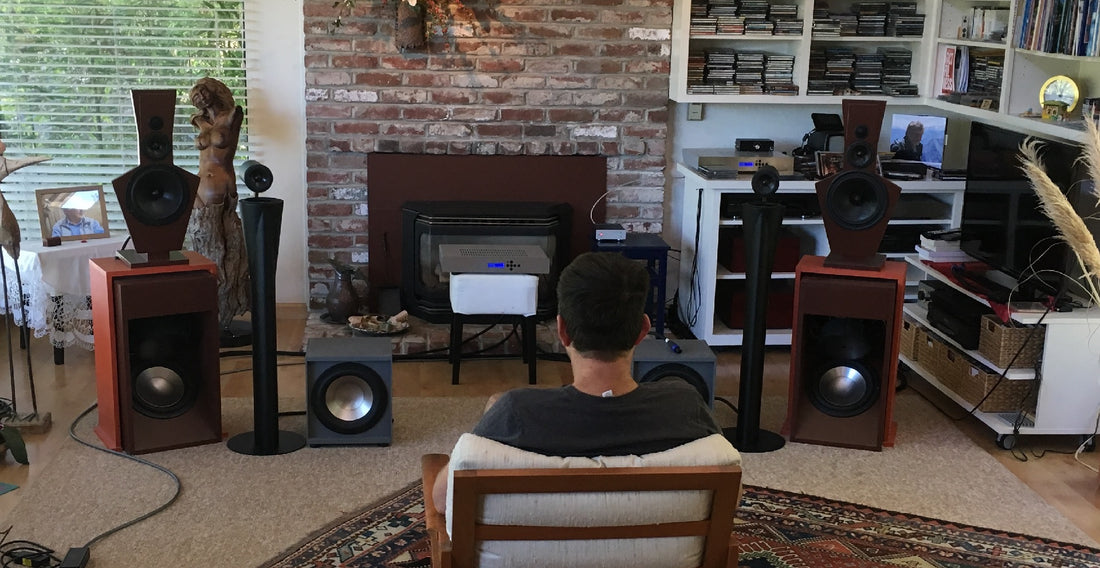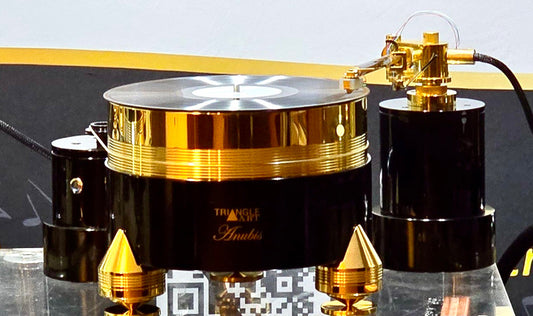As the second day of the 2019 California Audio Show was taking place, a smaller, more intimate demonstration of the reproduction of recorded music was unfolding across the Bay in Marin County. For the third time this year, a select group of about 30 music lovers were treated to an open house at the residence of the late audio legend, Siegfried Linkwitz, and his wife (now widow), Eike.
The occasion was another “real-world” audition of Linkwitz’s ultimate speaker design, the magicLX521.4, along with the smaller LXsirius. The 521 is a four-way, six-driver, boxless system with dedicated amplification for each driver. There are two 10” woofers mounted at vertically angled opposition to each other in an open cabinet that has no front or back panel, with a minimal baffle on top that has an 8” lower-midrange driver, a 4” upper-midrange driver, and two 1” dome tweeters (one of which faces the rear). Special cables provide the connection between two six-channel amplifiers and the drivers.
The LXsirius represents an evolution of the Pluto speaker, and features an upward-facing 6” woofer at the top of a graceful column, just above which is a small forward-firing full-range driver. The original Pluto used a PVC pipe for the column, and looked very DIY. The LXsirius has taken the same basic driver arrangement and placed it in a refined and elegant enclosure that is much more décor-friendly. It is available as a stand-alone speaker or augmented with several choices of subwoofers. While Linkwitz designs have always been authorized for individual use with the purchase of plans, at least one company is marketing an unlicensed version of the Pluto.

Now that Siegfried Linkwitz has passed, the gracious and charming Eike carries on his tradition of welcoming music lovers into the home. She provides a wonderful table of hors d’oeuvres and beverages. The demonstrations are conducted by Dr. Frank Brenner, who has taken up the administration of Linkwitzlab.com from his hometown of Stuttgart, Germany, along with Craig Allison, a close Linkwitz family friend who was the co-operator of several notable hi-fi shops in the North Bay for 30 years.
Frank left a career as a physician to become an airline pilot for Lufthansa, and makes regular flights to California. His interest in building speakers led him to research on the Internet and, ultimately, to the Linkwitz Lab website. He purchased the components for Siegfried’s previous design, the Orion, in kit form and was “blown away” with the sound. When the LX521 design was published, he immediately ordered the parts and built what turned out to be the second pair in existence at the time. Frank took a poll on the Linkwitzlab forum and found overwhelming interest in the speakers. In 2013, with Siegfried’s approval, he decided to market kits and fully-assembled units.

Eike Linkwitz and Dr. Frank Brenner.
He has continued to refine the system wiring and electronics. Where earlier designs relied on an analog crossover feeding multi-channel amps from companies such as ATI, Frank helped to develop the dedicated “Powerbox” amps with digital or analog processing. He has also rerouted the wiring so that it is contained within the wood panels — not sticking out in plain sight.
As you can see from the photo, most audiophiles would consider the room in which the speakers reside to be an acoustical nightmare — nearly floor-to-ceiling windows on both sides, a brick fireplace façade to the rear, and bookshelves on one other side. There has been no attempt to provide acoustic treatments.

The Linkwitz LX 521.4 won’t be mistaken for anything else.
Eike had arranged staggered appointments for the guests, so that at any given time there were about ten people in the living room. Attendees took turns in the “sweet spot” seat, but the sound was focused and compelling from nearly anywhere in the room. That the speakers can present a coherent, almost holographic soundstage in such an environment is a testament to the Linkwitz genius and the fact that they deserve the “magic” appellation.
Frank supplied a varied set of musical selections, from the familiar to the obscure, each played at an individually predetermined volume level. One of Siegfried’s concepts was that there is an optimal volume setting for any given piece.
Siegfried was a highly regarded figure in the audio industry, and I consider myself fortunate for having had the opportunity to visit him in his home several years ago, when he was demonstrating the Orion speaker model. He is best remembered as the co-creator of the Linkwitz-Riley crossover, as well as the designer of Audio Artistry speakers.
The Linkwitzlab website contains a staggering amount of information, both technical and philosophical. It is well worth a visit. For those interested in purchase information, look here.
P.S. I asked Eike about the unusual choice of orange for Siegfried’s own bass cabinet – she replied that it was her favorite color, and that of the Golden Gate Bridge…



